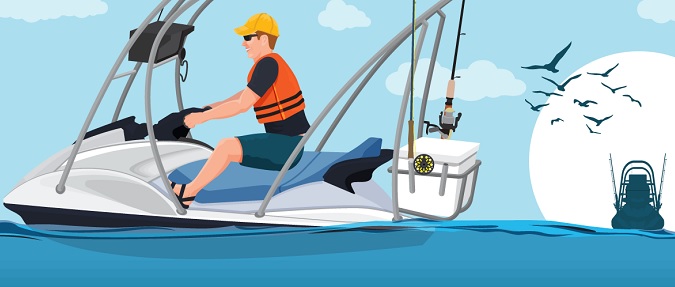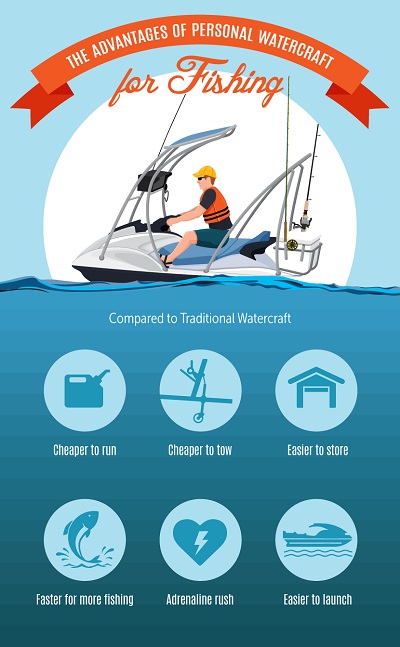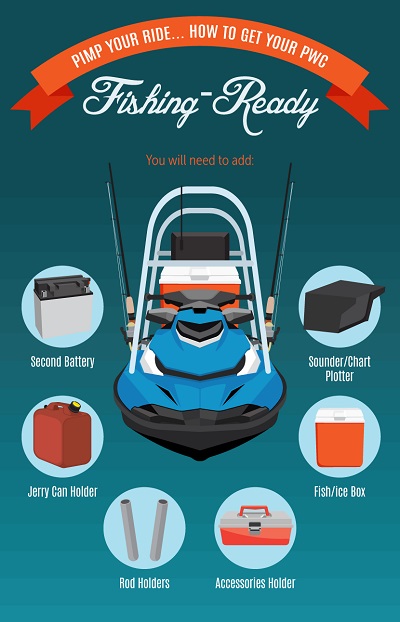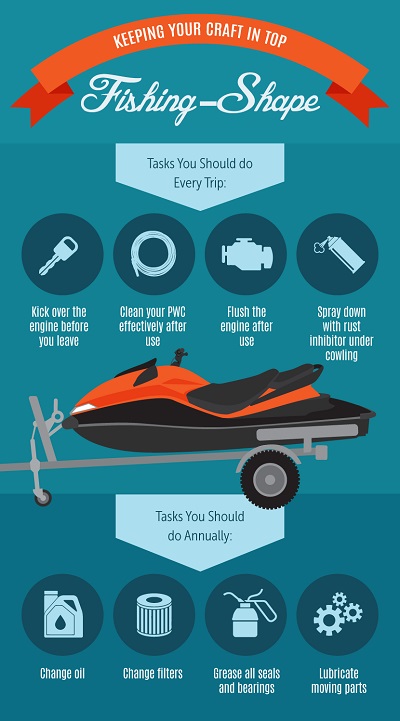
With their small size and limited amenities, personal watercraft – or PWC – would hardly be considered typical vessels for chasing large fish. But what they lack in onboard amenities, they make up for in convenience and affordability, and that is exactly why many choose them as fishing battle wagons.
Personal Watercraft Benefits
Boats are expensive – to buy, run, manage, and maintain. The purchase price of a suitable fishing boat alone can give you heart palpitations and cause your wallet to wince in pain. This is before you consider the need for a tow vehicle, which can run into the thousands in additional expense.
The lighter weight of a PWC offers some advantages, such as opening up new fishing grounds away from the crowds and allowing for beach launches. One person can launch a PWC and drag it through shallow water before heading off. There’s no need for a crew. And can you imagine trying to drag a one-ton boat across a beach to launch it on your own? I certainly can’t! With a PWC, you’re not limited to well-marked launching facilities.
The speed of a PWC makes it more efficient, so not only can you launch closer to the action, you can get there faster as well. With speeds approaching 75 mph for high-end machines, you can be fishing before your friend with a larger boat has even hit the water, let alone arrived at the best spot. You’d be on your way back
in with a few striped bass as he’s heading out.
Storage and maneuverability are also important considerations. A PWC’s footprint is much smaller than a boat’s, so if you have limited space, the smaller craft makes sense. They can fit in a small garage or parking area and are easier to get into such spaces. Boats are heavier, need larger trailers, and are near impossible to move yourself, but you can tow a PWC with nearly any vehicle.
If you’re not already convinced, consider that a PWC also offers an adrenalin rush that a boat simply cannot. If you hook a game fish from a PWC, it might tow you around!
Fishing Additions
With the increase in popularity of the modern PWC as a fishing vessel, companies have really stepped up when it comes to aftermarket additions. There are myriad companies producing rod holders, electronics mounts, side pods, fish boxes, and even canopies. If you’re serious about fishing, you can easily kit out your PWC, and adding these bells and whistles can make your experience more enjoyable.
If your budget is tight, you could conceivably head out with just a small tackle tray and a rod, but you could also make modifications yourself that will make the fishing experience easier. For example, you can easily set up your own rod holder and fish box, attaching them to the craft at the tow point, generally located at the rear of the seat. Simply get an ice chest that you can fit on the rear of the craft and screw the rod holders into its sides. This way, you won’t have fish flapping about in the foot wells, which is not only annoying, but can also cause injury due to fish spines.
To attach the fish box, you need to first add some kind of hook point that will extend under the rear of the craft, creating an anchor point. You can get a strong 90-degree bracket and bend one end into a hook shape. Then attach it to the bottom of the fish box by bolting it through with washers to ensure they don’t pull through. This will hook under the end of the hull. To secure the front take a stainless-steel saddle and bolt it to the forward-facing side of the fish box. Before you screw it off, slide a stainless-steel turnbuckle onto the saddle. Using a stainless-steel shackle, attach the other end to the tow point at the rear of the seat and tighten until the box is secure.
You can purchase rod holders from a boat store and attach them to the sides or the back of the fish box with bolts and washers, or you can make them yourself out of plastic piping. To create three rod holders, join three quarter-inch T-junctions together end to end to create a bottom with three upward-facing points. Then add a 9-inch length of quarter-inch PVC pipe to the free upward-facing end of the T-junctions, and glue the whole thing together using pipe cement. You can then affix this to the ice box using bolts. This makes a durable and affordable rod holder. The only other thing I would add is a small length of rope and a clip so your fishing rod doesn’t accidentally end up on the bottom of the ocean.
Maintenance
Regular maintenance of your PWC is crucial. It’s a lot easier than looking after a boat, but that said, there are some things you should check regularly to ensure you don’t get stranded.
Whenever you take your PWC out, be sure to check the fluid levels and give it a quick test start in the driveway before you head to the ramp. Taking a lengthy journey to the launch site, only to find your vessel will not start is upsetting, especially if the fish are biting. When checking the craft at home, look over it for any damage or loose parts and repair or replace them as soon as possible.
Once back on the trailer, the boat’s engine and cooling system need flushing to remove salt water. Each craft is different, so consult the manual first for the correct procedure. Once done, you must remove the residual water in the engine and exhaust. To do this, start the engine on the trailer and give the throttle a few blips. This will blast the remaining water out of the exhaust pipes and reduce the chance of corrosion. It is entirely safe to do this, but do not run the engine for more than 15 seconds and do not hold the throttle at full.
At least once a year you should drain the engine oil, change the filter, and replace the oil. At this time, it is also useful to grease all seals and bearings and lubricate any moving parts.
Other Factors to Consider
While PWCs are easier to handle, you need to consider the implications of their size and therefore the restrictions you will face. I cannot overstate the importance of safety. You are fishing on what is essentially a platform – you’re not safely encapsulated in a boat with high sides. For this reason, a life vest is mandatory.
Also, be sure to connect the engine’s safety shut-off to your wrist or vest and even consider loosely connecting yourself to the craft with a quick-release clip on your jacket. This way, should you fall off, the engine will stop, and the PWC will not drift away from you.
Fuel is another consideration. You don’t have space for heaps of equipment, but fuel is critical: make sure you carry enough fuel for your expected journey. If you are at all unsure, do not test the limits of your skills or the capacity of your fuel tank. It would be wise to buy a jerry can holder and carry spare fuel.
Expanding the horizons of your PWC beyond pure recreation to fishing makes sense. Follow the correct safety and maintenance procedures and set up your vessel as explained in this article, and you’ll be ready to get out there and beat everyone else to the big fish!

